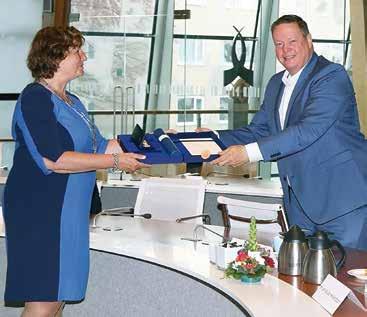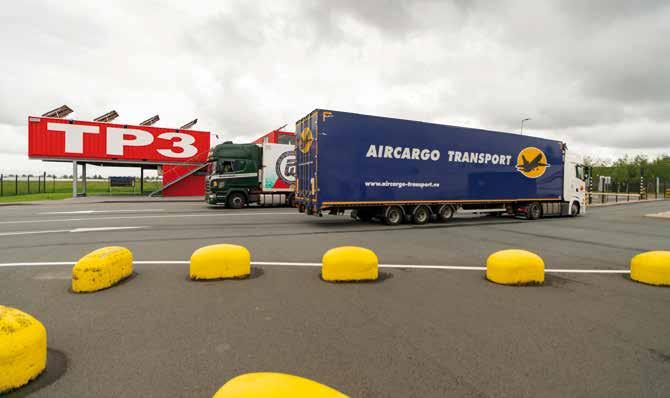
7 minute read
ULD optimisation within the air cargo chain
by Cargomedia
From an idea and research to a concrete product
Anand Bihari was Regional ULD Coordinator at AirBridgeCargo Airlines until the end of 2020. He was responsible for, amongst other things, the flow of ULDs within Europe and he had to ensure that the correct ULD type was in the correct place at the correct time and that the correct numbers were available for both scheduled flights as well as the many ad hoc charter flights. Part of this involved the returning of empty ULDs by customers.
Advertisement
Text Esther Kort-Boreas
Anand: “Approximately 15-20% of our ULD fleet is with the forwarders. The general rule is that a ULD should be back with the airline within five days but, in many cases, this does not happen. For various reasons, many ULDs remain at the forwarders for a longer period and are only slowly returned to the airline and this is then at the expense of efficient ULD usage and can also have operational and financial consequences. The key question is: how do we get ULDs back as quickly as possible?” How does returning an empty ULD work? “A ULD is with an agent. The number shown on the ULD is written down on a sheet of paper. The empty ULD and the paper document are then delivered to the handling agent. The handling agent’s ULD Control Section checks if the number on the paper is the same as the number on the ULD. If so then the ULD number is typed into the handling agent’s own system in order that they can advise the airline that the ULD has been returned. This process was thought up decades ago and is often still being undertaken in the exact same way. It can be concluded that the same data is being input several times by various parties as the data flows between chain partners are independent of each other and not available to all parties. Apart from this being sensitive to error (typing errors with ULD numbers often happen), it also costs unnecessary manpower.”
What frequently happens in practice is that, for example, according to the ULD system of the airline or handling agent, ten pallets should be with forwarder X. The forwarder goes to look in the warehouse and advises the airline that there are only six. The question is: where are the other four? Investigating this and actually localising these four pallets is time-consuming for both the airline and the forwarder. A forwarder often uses systems that make it impossible to search at the ULD level. Therefore, multiple messages from the airline and forwarder’s different systems are needed to try to localise the missing pallets. Again, this is an example of where data sharing between the vari-
Anand Bihari Dennis Borst Lars Koopman


ous chain partners can be very useful.
Currently there are initiatives by IATA and some other parties to modernise ULD processes and performance. Many of these initiatives are, however, still at the pilot stage and will not be available in practice in the short term.”
Anand raised with CargoHub the issues he had experienced and the possible solution he envisaged. Together they began to brainstorm about modernising and, most especially, digitalising the process. Why not develop an app to simplify the process for all parties? Further research was needed.
Research
Dennis Borst undertook his graduation research for his logistics studies at Inholland University of Applied Sciences with handling agent dnata. He is now employed by CargoHub and is taking a very close look at this process at several agents.
“I began at Geodis, a major customer of AirBridgeCargo. Menzies, the airline’s handling agent, has now become enthusiastic”, Dennis says. “Returning empty ULDs involves a lot of manual activity and paperwork. This has been the case for years. Every ULD has a unique code consisting of the type (e.g. PMCQ7), some numbers followed by the letter code of the owner (the airline) or of the company from which the airline hired the ULD. Often agents take their import cargo complete with the pallet and break the cargo down in their own warehouse which speeds up transfer to the customer and also saves costs. The ULD must, however, be returned to the airline at a specific time. To ensure that this happens in an orderly manner, the agent prepares a ULD stack list including the codes. The codes are written on a sheet of paper that the driver, who is taking the ULDs back to the handling agent, must hand over. The ULD Control Section checks that the codes on the paper correspond with the codes on the ULDs being returned and signs the paper. The codes are then entered into their own system. By now the sheet of paper has changed hands several times and incorrectly copying a code, a number or a letter is an error just waiting to happen. Research has shown that no less than one in five documents contains a coding error. Airlines consequently receive a notification of the location of their ULDs which turns out to be incorrect.”
Product
Lars Koopman of Geodis says: “We receive many ULDs and break down the cargo. We then sort the ULDs per handling agent and put them in the correct racks. When the warehouse is busy, stocks increase. A stack list is prepared from the piles. All details and codes of the ULDs are shown on this list. The driver who delivers the ULDs to the handling agent has the list with him. He has them sign it and the signed copy is returned to us. When an airline ascertains that an incorrect ULD has been returned, we are asked what we have done with a specific ULD. We have to delve into our files and search for the relevant number and this is a time-consuming job.
Innovation is one of Geodis’ five core values. This project is a great example of innovation in air cargo. In fact, our other four core values also fit very well in this context: commitment, trust, solidarity and passion. I think these core values speak for themselves”, Lars says.
From manual to digital
“We see advantages in the ULD app, we support the project and are putting in both time and manpower”, says Lars. “The people on the work floor have told me that they find working with it both a pleasure and
useful. Extensive testing is being done at present. At present this is still manual, the first data transfer has not yet taken place. The process of handing back ULDs to the handling agent might seem simple but it is complex. We welcome the simplification and digitalisation the ULD app offers. It would be really good if the hauliers were also to work with this app so that also in this area the link in the chain can be closed.”
Benefits for all parties with the ULD app
The airline has fewer (or no) email or telephone contacts with the agent as, due to the systematic automatic input, the registration of ULD codes is far more accurate. As a result, there are fewer incorrect ULD numbers delivered or accepted. Airlines and agents can therefore agree better SLAs with each other. The agent no longer has to find out who the owner of the ULD is. This is easy for a ULD with an airline code but, if the ULD has been rented, it is not as simple as 1-2-3 for an agent to find out from who it is. The owner of a ULD is automatically registered in the app.
The handling agent accepting pallets no longer needs to undertake any research as the system clearly states from which airline each pallet is. Work is taken off the hands of ULD control as pallets can also be accepted, for instance, by a warehouse employee using the mobile app. The driver’s job delivering the ULDs to the handling agent is also far completed much quicker.
Is a ULD damaged? A photograph can be taken using the app and this is then immediately available in the system. In this way all parties are aware of what is happening. Using the ULD app saves time operationally. A ULD stack list is produced with just a couple of clicks in the app. This stack list is then digitally available for the handling agent’s ULD control. Paper documents are no longer needed. Furthermore, the handling agent can see when the agent will be returning ULDs.
More information
To participate in the pilot or for further information about the ULD app:
Dennis Borst Product manager support@cargohub.nl
Royal recognition for Henk-Jan van Keulen
In April, AirBridgeCargo Airlines Country Manager, the Netherlands, Henk-Jan van Keulen, has been appointed by the King of the Netherlands as Member of the Order of Oranje-Nassau for his voluntary work as head police-officer unit The Hague. On behalf of Cargo Magazine, congratulations on this recognition! Photography: AirBridge Cargo Airlines











